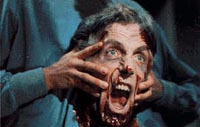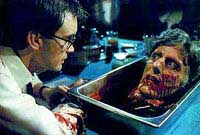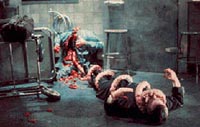
[Archive] [Links] [Store] [Home]
e-mail:Smokey X. Digger

 

 |
Filming the Unfilmable: The Cinema of H.P. Lovecraft (Part 4)
“I have conquered brain-death!” - Jeffrey Combs in Reanimator
Stuart Gordon’s Reanimator focuses more on capturing the spirit of its source material rather than trying to recreate it, which in hindsight was a smart move. While the plot of the film veers wildly from Lovecraft’s story, it maintains the visceral, nihilistic quality of the prose. The film makes nods towards Frankenstein and Psycho and contains many tropes of the popular film forms of the day. Given the story’s character driven nature, poor performances would have doomed the film. Luckily all the performances are adequate except for that of the lead role, which is perfect. Jeffrey Combs gives a frenzied, obsessed performance as Herbert West that perfectly communicates the dementia and
obliviousness of the character.
As little as the plot resembles the source material, there are several common aspects. The characterization of Herbert West is left the same; although it leans toward West’s depiction in the second half of the story. As Lovecraft wrote: “dangers he met unflinchingly, crimes he committed unmoved”. The fate of Dean Halsey is similar, in both
versions he is reanimated by West, becoming a zombie with “nauseous eyes and voiceless simianism”, institutionalized “where it beat its head against the walls of a padded cell”. The story’s Sir Eric Moreland Clapham-Lee has his parallel in the film’s Dr. Carl Hill; both become West’s headless nemesis. Clapham-Lee is reanimated by West after being nearly
decapitated in a plane crash, Hill has his head forcibly removed by West and is then brought back. They both fit Lovecraft’s description of Clapham-Lee, “a fellow physician who knew about his experiments and could have duplicated them”. The “wax face with
eyes of painted glass” worn by Clapham-Lee is parodied in the film by the anatomical model head used by Hill to sneak past the morgue attendant.
The only character motivation that is altered is that of the tale’s narrator, represented in the film by the character of Dan Cain. Both are classmates of and assistants to West, but their degrees of involvement are different. The narrator is enthralled by
West, calling himself his “inseparable assistant”. Of West’s experiments he was “fascinated utterly” and “exceptionally tolerant”. Dan Cain (portrayed by Bruce Abbott) is initially skeptical of West until experiments on his own cat prove him wrong, even then
he is a somewhat unwilling assistant. After the morgue scene and death of Halsey we can sense his conflict; he has gone too far with West and has no choice but to continue to cast
his lot with a madman.
The film is clearly influenced by the slasher / gore films of the late 1970s and early 1980s. It seems that every reanimation has an endless supply of blood to drool, and there are several graphic killings. An example of a classic gore film cliché occurs during the
scene in Dr. Hill’s class. After a bonesaw is used on a cadaver, the camera gives us a long-close up of it. As any genre fan knows, a close-up on an implement of this kind means that it will be used for a purpose other than what it was intended for. Sure enough,
several scenes later, there’s the bonesaw being pushed through a reanimated corpse by West. A more innocent homage occurs after Dan and Meghan’s sex scene. Dan playfully stalks Meghan while wearing a bedsheet, reminiscent of a Michael Myers stunt in Halloween.
There are other nods to classic genre moments, some subtle and some obvious. The most controversial is Reanimator’s score which borrows heavily from Bernard Herrman’s score from Hitchcock’s Psycho, often recycling whole themes. Defenders of the music call it “a playful reworking”, those who object do so vehemently. As West and Cain battle the reanimated cat in the cellar, a swinging ceiling lamp is struck and begins to swing, casting moving shadows that are reminiscent of the discovery of “Mother” in Psycho. Frankenstein is referenced when the first successful reanimation comes to life, a pan down the arm of the corpse reveals the hand slowly twitching to life. West would have perhaps screamed “It’s alive!” had the corpse not immediately commenced tossing him around the room.
The gore of the film is actually not too far from incidents in the source text. In the story the reanimated Halsey mauls West and the narrator, then goes on a killing spree that leaves “seventeen maimed and shapeless remnants of bodies” in its wake. There are even mentions of cannibalism: Halsey reportedly ate portions of his victims, and the reanimated
boxer returns to West “having between its teeth a snow white, terrible, cylindrical object terminating in a tiny hand”. In the story’s conclusion, Clapham-Lee leads his zombie legions against West. At the asylum they release Dean Halsey while beating, biting, and
trampling the attendants. When they finally get their hands on West, they literally tear him to pieces. This is all echoed in the film’s over-the-top conclusion, in which West, Cain and Meghan face off against Dr. Hill and his naked, lobotomized zombie slaves.
The other genre that Reanimator draws upon is the type of “college film” that was popular in the mid-80s. These films were usually lowbrow comedies such as Revenge of the Nerds, but despite Reanimator’s wildly different subject matter its characters can be seen as stock characters from this genre. Dean Halsey is the prototypical Dean: a harsh disciplinarian who misunderstands the young generation; his own daughter calls him “the
world’s last Puritan”. Dan becomes the uber-student: top of the class, athletic, and with an attractive blonde girlfriend. West is the neurotic, nerdy outsider who causes conflict with whomever he comes in contact. Certain plot points could also be construed as borrowed from this genre: the compromising relationship between star student and Dean’s daughter (Dan and Meghan), and the uneasy alliance between the nerd and the popular student (Herbert and Dan).
As Lovecraft scholar Peter Cannon puts it: “Only in a Lovecraft story could two young men not pursue attractive female specimens for their experiments, remaining bachelors for seventeen years, all without a hint of deviant sexual behavior” (Cannon 40).
Reanimator, however, is not exempt from the unwritten rule that every film must have a love interest, and it delivers on two very different levels. The more traditional love interest is between Dan and Meghan who are engaged. The deviant sexual behavior is manifested by Dr. Hill’s obsession with Meghan. Director Stuart Gordon, who would become known for his love of over-the-top and disturbing scenes used this obsession to create the first in a long line of outrageous shots. After kidnapping Meghan, the decapitated and reanimated Dr. Hill engages in an intimate activity with her in the
infamous “head giving head” scene. The presence of a love interest alone would have been enough to nauseate Lovecraft, but the extreme nature of this scene would surely leave him aghast.
The question of “attractive female specimens” is further addressed in the sequel Bride of Reanimator which veers even further away from Lovecraft. This film begins in the fifth part of the source text where West and his assistant are army surgeons in Flanders, although the film moves them to Peru. The vats of reptile tissue are referenced
by West’s experiments with iguanas. From that point on the film toes the line between parody and homage to Bride of Frankenstein as West and Cain assemble a woman of various parts including Cain’s dead fiancee’s heart. The final laboratory scene references
many different Frankenstein films; most obviously the awkward movements of the female creation recalling Elsa Lanchester in Bride of Frankenstein. The long hair and loose shirt of Dan Cain and the overhead camera angles echo the Frankenstein films made in the
1960s by the British horror factory Hammer Studios. Despite the film’s aspirations it is little more than a muddled piece of camp, notable only for another spot-on performance from Jeffrey Combs.
“a rough-hewn amateurish affair ... in a pitifully feeble and hackneyed manner, containing not the slightest subtlety or technical skill in plot, directing, or acting.” - H.P. Lovecraft, from an unpublished film review, 1917
Lovecraft’s “all-important atmosphere” is more often than not the stumbling block encountered by Lovecraftian filmmakers. Die Monster Die! and The Dunwich Horror find themselves hopelessly overmatched by their sources, resorting to ill-conceived augmentations that further obscure the essence of Lovecraft’s literary tradition. The
elements that make the tales so eerily effective are simply not present in the films, because the filmmakers were not up to the task. The relative lack of resources is a factor but does not explain all; “The Dunwich Horror” provided a creature that was invisible for all but a brief while and the film still managed to make it appear ridiculous. These films failed in their attempts to be true to the atmosphere of the originals, an atmosphere that seems to
be unfilmable.
The fact that Reanimator succeeds in recreating the mood of the source text cannot be argued, nor can its cult success and status. What can be argued, however, is that the story “Herbert West: Reanimator” is simply an easy target in that it runs contrary
to Lovecraft’s themes. Stuart Gordon didn’t replace insinuated horror with buckets of gore, for the blood and guts were already present. Not having to worry about recreating a mood of encroaching cosmic terror enabled Gordon to concentrate on updating the film
into an era more recognizable to the movie-going populace. This was a move that clearly paid off, resulting in success, notoriety, and of course sequels. Beyond Reanimator is scheduled for straight-to-video release in 2002.
None of these films are accurate representations of their source texts. They each work in their own ways to evoke images associated with Lovecraft with varying degrees of success. They have achieved favor among “B” movie enthusiasts and that seems to be the final extent of their legacy. Metro Goldwyn Mayer studios has released Die Monster Die! and The Dunwich Horror as part of their “Midnight Movie” video series, which pays tribute to the lesser grade films of late-night television, and Reanimator has become a high-selling DVD in the Internet stores. These films were never pleasing to critics and
certainly never would have pleased the man who would have been their harshest critic: H.P. Lovecraft. This passage, directed towards the horror films of his day, is from a letter Lovecraft wrote in 1933: “They are all the same - flat, hackneyed, synthetic, essentially
atmosphereless jumbles of conventional shrieks and mutterings and superficial, mechanical situations”. One can easily imagine Lovecraft applying this comment to the cinema spawned from his own fiction.
But what would it take to make an adequate adaptation of an H.P. Lovecraft story? Daniel Haller, the director of both Die Monster Die! and The Dunwich Horror has said that the advent of computer generated images should add a new dimension to
Lovecraftian filmmaking, but no one has yet tried their hand at it. Has the legacy of poor Lovecraft films soured the industry on the concept forever? We shall probably never see a big budget Hollywood attempt at Lovecraft, but the number of independent filmmakers cranking out Lovecraftian films and shorts suggests that perhaps someday someone will
successfully film the unfilmable.
Click here to see my sources and links to useful Lovecraft sites.
|
 "I said scratch my nose, dammit!"
"I said scratch my nose, dammit!"
 Herbert West and Dr. Hill.
Herbert West and Dr. Hill.
 There's always room for tentacles in Lovecraft.
There's always room for tentacles in Lovecraft.